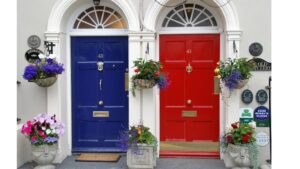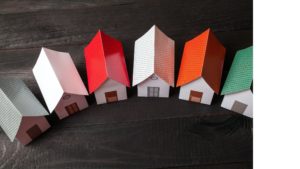Introduction:
The importance of colour in home front door design cannot be overstated. Front doors are the first impression of your home, and the colours you choose can significantly influence how people perceive your property. Whether you’re repainting or designing a new one, understanding the psychological effects of different door colours is key to creating a welcoming and appealing entrance for your home.
The Basics of Colour Psychology
To begin with, colour psychology plays a vital role in how we perceive a home’s entrance. The front door is often the focal point of a house, and the colour you select can convey a variety of emotions and messages. Additionally, it’s essential to recognize that cultural and personal factors can also influence how people interpret colour.
Warm Colours for Front Doors
Warm colours, such as red, orange, and yellow, are known for their ability to evoke a sense of warmth and welcome. These colours can make your front door feel inviting and create a cosy ambiance. For instance, a red front door can signify a sense of warmth and passion. While a cheerful yellow can exude a friendly and inviting atmosphere. In this way, warm colours set a positive tone for your home.
Cool Colours for Front Doors
Cool colours, including blue, green, and purple, can offer a sense of calm and serenity to your home’s entrance. Consequently, a blue front door can create a tranquil and peaceful atmosphere, while green can symbolize growth and balance. As a result, cool colours for front doors provide a refreshing and relaxing entry point to your home.
Neutral Colours for Front Doors
Neutral colours like white, natural wood, and grey offer a classic and timeless look for front doors. On the other hand, a white can signify simplicity and purity, while grey can add sophistication and neutrality to your entrance. Similarly, natural wood tones provide a versatile backdrop for other design elements and create an elegant first impression.

Bold and Vibrant for Front Doors
Bold colours, such as deep reds, bright yellows, and rich purples, can add a dynamic and energetic element to your front door. By the same token, a deep red can symbolize strength and confidence, while a vibrant yellow can project optimism and energy. In the same way, these bold colours for front doors make a strong and memorable statement that captivates the attention of visitors.
Striking Combinations
Colour combinations can create a bold entryway. Different colour schemes, such as complementary, analogous, and triadic, can create a pleasing or contrasting look. For instance, combining blue and white in an analogous scheme can evoke a sense of serenity and purity. While using complementary colours like red and green can create a vibrant and visually appealing contrast for your front door. If in doubt, stick to one colour.

Practical Tips for Choosing Colours
When selecting colours, consider factors like the overall exterior colour palette, architectural style, and personal preferences. In addition to that, samples and swatches are invaluable tools in the decision-making process. Notably, take your time to choose the right colour that reflects your personality and creates an inviting atmosphere for your home’s entrance.
Trends and Future Predictions
Front door colour trends are continuously evolving. At present, popular choices include bold and vibrant colours like cerulean blue, spicy mustard, fuchsia pink, stone, crimson red. Moving forward, in the future, we can expect to see more homeowners exploring unique and personalized door designs as a way to make their homes stand out. Remember, your front door isn’t something you will paint every year so its important to choose something you love. Check out Houzz to see a full range of inspirational door designs and colours.
Conclusion
Incorporating the psychology of colour into your home front door design can significantly impact the first impression your home makes. In summary, whether you want to create a warm and inviting entrance. A tranquil and serene atmosphere, or a bold and energetic statement. The colour you choose sets the tone for your home. In light of this, by understanding how colours influence perception, you can make informed decisions that reflect your style and create an appealing entry point to your home.
You might be interested in these other blog posts.





